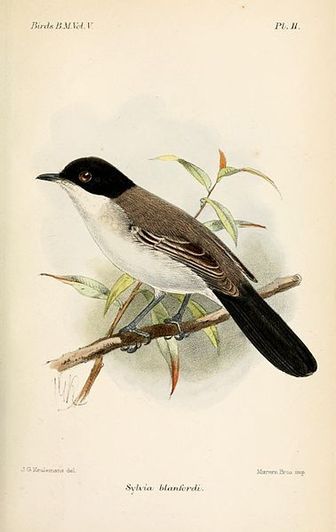Arabian Warbler

The Arabian Warbler is classified as Least Concern. Does not qualify for a more at risk category. Widespread and abundant taxa are included in this category.
For the purposes of our bird news services, Arabian Warbler is classed as ungraded: species which are unlikely to appear as wild birds in Britain or Ireland (Note that rarity levels are currently applied nationally and may not reflect local variations in abundance. More
Eagles and Arabian Warbler - Winterer and one of the rarest resident species were the main targets for my most recent research trip for our planned bird guide to Israel. Arabian Warbler of the subspecies negevensis, only to be found on both the Israeli and the Jordan parts of the Southern Arava Valley has gone through a dramatic decline in its population size and is considered as critically endangered. More
Arabian Warbler, 2 Desert Warblers and some Desert Larks At night, we eared (but not see) one Bruce's Tawny Owl 20 November 2001. We go to Mirbat (about 60 km East of Salalah) to see sea birds (SITE # 23). Good morning with 3 Socotra Cormorants, about 10 Persian Shearwaters, 15 Pale-footed Shearwaters and 40 Masked Boobies. More
Also on the 23rd, two Arabian Warblers were found singing near Hazeva in the warm, spring like conditions. The next day, however, a westerly storm made viewing conditions rather difficult in the desert though some nice species were eventually found including a Striated Scops Owl in Nahal Grofit, and the long staying Menetries's Warbler in Nahal Zihor. More
the acasia areas where we knew the Arabian Warbler had its territory. We didn't know the exact place where the warbler had been so we started to search all the bushes. After 5 minutes searching we found (again) male White-throated Robin. Also Garden Warbler and Barred Warbler were found, but we checked all the bushes without finding the Arabian Warbler. More
An Arabian Warbler was tempted into view and showed delightfully well. An excellent find by Jackie resulted us enjoying great views of a roosting European Nightjar under a bush (and another was flushed nearby). Along an area of reeds we located Clamorous Reed and Sedge Warblers. Overhead large numbers of ‘Dhofar Swifts’ were present and often swooping down onto the water to drink. More
Family : Sylviidae
Genus : Sylvia
Species : leucomelaena
Authority : (Ehrenberg, 1833)

